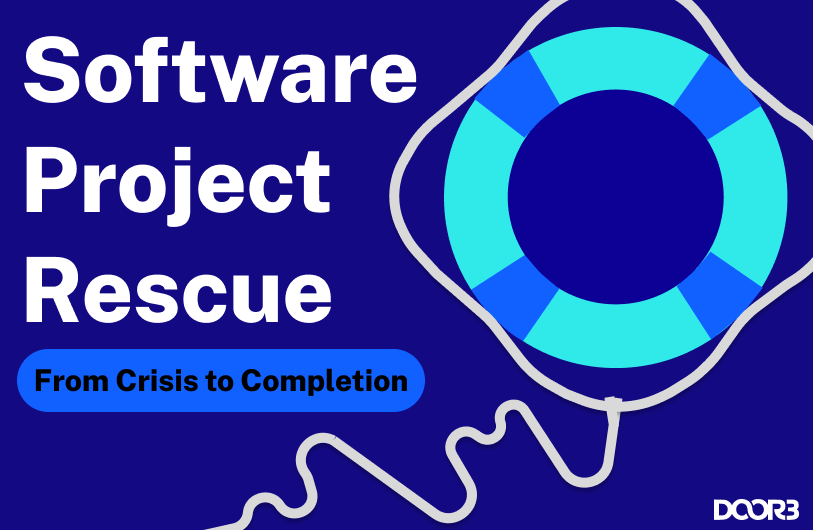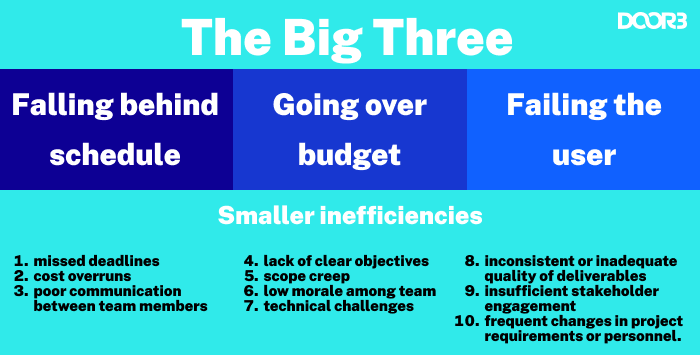Software Project Rescue: From Crisis to Completion
04.22.2024
Signs of a sinking ship
Picture this, you set out to create a software solution that was guaranteed to boost your business’s efficiency, in your search for developers you found a team that promised you that they could build your solution in 6 months, and under your original budget.
12 months later your way over budget and your beginning to see how when things sound too good to be true, they usually are. Now, you need a software project rescue.
What is software project rescue?
A software project rescue refers to the process of intervening in a software development project that is struggling, at risk, or actively failing to meet its expectations as a business or consumer solution. This can include projects that are currently in development, or solutions that have been previously built and are now failing to operate due to poor maintenance or bad initial development.

Common characteristics of projects with the impending need for a software project rescue include the big three: falling behind schedule, going over budget, or failing to meet the user needs or business objectives. These three characteristics are often the result of multiple smaller inefficiencies, such as:
-
Missed deadlines
-
Cost overruns
-
Poor communication between team members
-
Lack of clear objectives
-
Scope creep
-
Low morale among team members
-
Technical challenges
-
Inconsistent or inadequate quality of deliverables
-
Insufficient stakeholder engagement
-
Frequent changes in project requirements or personnel.
Any mixture of these or other slowdowns can turn a small delay into a big problem, and often your only options are to abandon all that hard work or conduct a software project rescue.
Why do software projects fail?
Every software project failure has nuanced reasoning behind its downturn. There’s no completely accurate recipe for a software project failure, but there are a few culprits we see in the early days that may spell bad omens for where the project is heading.
Signs a project might need a software project rescue soon
1. Constantly changing requirements
How can you score if the goal post is constantly shifting? Constantly changing a project’s requirements makes it impossible for developers to stay on a schedule. Requirement changes are a bit more manageable when using an Agile methodology, but it’s still recommended to stay on path as much as possible during a development process.
2. Poor communication
Software development requires a lot of translation between stakeholders and developers, usually a project manager helps to streamline that process, but if the PM isn’t doing their job successfully, that less-than-stellar communication is almost guaranteed to throw a wrench in the process at some point.
3. Missed deadlines and overrun budgets
Perhaps the most obvious two on the list, once budgets get blown or deadlines are consistently missed it’s time to call in the project rescue team at DOOR3. It’s very rare for an overrun budget to be recovered, but the earlier you recognize an issue, the faster you can stop the bleeding.
4. Low morale
Is low morale really that big of a sign of a failing project? It can be! Especially with internal development projects.
We’ve had businesses reach out to us saying that the one internal developer on their team has quit in a blaze of glory, leaving their software project in an unmaintained mess of a state. Should there ever be a situation where only one person knows the ins and outs of a piece of custom software? Definitely not, but it happens more than you think, and when it does a software project rescue is unavoidable.
Other signs include technology misalignment, lack of stakeholder involvement and poor quality development.
Root causes of project failures
We’ve seen the signs of an impending software project rescue, but let’s dig a little deeper and find where these problems begin during a software development project.
1. Poor project planning: There’s a difference between aspirational goals and totally unrealistic planning. If you’ve set the expectation of lightning fast development with no margin for error of slowdowns, your project is destined to fail. Building in a little wiggle room is a critical pre-development first step with scheduling.
2. Technical incompetence: Always vet the third party developers you speak with. Lower end developers will lock you in with cheap pricing and promises of knowing every specific technology you’re seeking out, only to blow your schedule and trap you into either paying more or pulling the project entirely.
3. Resource constraints: Software development is expensive, there’s no way around it. Trying to take on a large development project without the proper resources will result in an underbaked solution that serves no one. So if you don’t have the resources for the project of your dreams, boil the solution down to the exclusive needs.
During a technical discovery with DOOR3, we help our clients define what must be included and what can be added in a second version of the product. Keeping the desired solution pragmatic and realistic.
4. Ineffective leadership: Stakeholders who constantly argue, CEOs who don’t know what they want, and micromanaging executives often get in their own way more than they support their own project. Software can’t fix poor management skills, so make sure your team is aligned before starting a project.
Is it better to conduct a software project rescue, or start over?
When do you decide it’s better to scrap the whole thing instead of conducting a software project rescue? The answer can be different depending on the circumstances, but the first step would be to conduct a risk assessment of each option.
Are there any timeline constraints that would impact the project’s viability? How is the quality of the work already done? Will we have to redo most of it? How much have you already invested? What about the technology being used? Is it cutting edge or already outdated?
If the code that’s been developed is very low quality and the technology is already showing signs of aging, it’s probably best to bring what you have as a reference point to a different developer to start over. While if your timeline is still viable and your investment is substantial, then it may be better to conduct the software project rescue. This decision should be made under the advisory of the team that will take over the development regardless of rescuing or restarting.
Factors influencing the software project rescue decision-making process
Contractual and legal obligations are the bedrock of making a decision like conducting a software project rescue. The last thing a company wants is to have to go through litigation in the middle of a failing project. Once it has been confirmed that there are no obligations that must be met before making a decision, project’s stakeholders must put their heads together and make a decision.
Stakeholders should consider a few things in their software project rescue decision making process:
-
Does this project still align with our strategic goals?
-
What is the overall financial impact?
-
Do we have the necessary resources available?
-
What are the current market dynamics for our industry?
Depending on where in the matrix your team lies on these four points should provide direction to whether or not a project should be rescued or simply must start over.
How to Rescue a Failing Software Project?

The above 8 step timeline provides businesses with a general process to follow when attempting to conduct a successful software project rescue. Additional strategies can help secure this process.
Key strategies for project recovery
1. Switch to Agile Methodology if not already
It is so much more cost-effective to fix errors as you go as opposed to going back and adjusting at the end within development. Waterfall methodology loses out on the opportunity to quickly iterate your codebase when errors present themselves.
2. Address technical debt
Accumulated technical debt should be managed and reduced as quickly as possible. Updating technologies and improving documentation can help to reduce debt and support future maintenance.
3. Bring in outside experts
If your do-it-all yourself approach got you into this mess in the first place, don’t make the same mistake again. Bring in vetted experts like DOOR3 to assess and plan your software project rescue, and never let an unqualified hand touch your code again.
DOOR3’s Software Project Rescue Services
Our software project rescue services are totally bespoke to each project that comes our way. With our two decades of experience, we’re smart enough to know that no project follows the same formula, but that there are a few services that we provide to assess what the most efficient route to a working solution might be.
Technical discovery
Our technical discovery services are the bedrock of what we provide as a software project rescue agency. You might be saying to yourself, “is it really worth spending more money just to take this holistic approach?”.
The answer is yes.
By giving us the space to fully analyze your project from conception to where you left it, we minimize error probability, define scope specifically, and reduce the overall time and resources spent to rescue your software. Other companies might tell you that you can reduce a discovery phase to cut costs, these are the same companies that will get you into a rescue situation in the first place.
We’ve got the receipts to prove it. We recently conducted a software project rescue for one of the world’s largest beverage and food companies. We told them that a technical discovery was tantamount to a successful rescue, and they allowed us to do the pre-work necessary to build a successful solution.
What we developed through that process would go on to be a massive success at the company, providing disparate data all in one place with straightforward analytics side-by-side to support adaptive strategy.
Curious as to who we conducted this project with? Reach out and we will be happy to provide more information.
Software Project Rescue Stages
We break our software project rescues into three overarching categories that we work through. These categories keep our general process intact, without hyper fixating on specific elements of the project rescue itself.
Stop the bleeding
Often what our clients need first from their software project rescue agency is a quick fix just to keep everything up and running while you look at long term solutions. We’re no stranger to getting you back to operational before we tackle the development of a stronger solution. A previous client of ours had their sole developer quit in a blaze of glory, leaving a disorganized and inoperable intranet that was the integral to the operation of the business. We understood the severity of the situation and were quick to bring the intranet back up to operational speeds while we moved on to the next step of development.
Analysis and presentation
Once the software has been stabilized, we begin our in-depth discovery process. Sorting what functionality the software has to have, what are the functionalities the stakeholders want, and what has already been built and can be salvaged. This process is extensive for us, making sure that all questions are answered before development begins. Once all the information is gathered, we present our findings and the subsequent plan for your software project rescue to all stakeholders, getting sign offs before we begin.
Execution
With the critical milestone of stakeholder approval reached. We begin our custom software development process incorporating any salvageable elements left by the previous team. This phase can appear very differently depending on the scope and scale of the project, but regardless of the project we apply an Agile methodology to emphasize iteration during development.
At the end of each step in the execution phase, we check back in with stakeholders to ensure that we are developing the product they were looking for with their initial team, and maybe even more than they were expecting.
The advantages of our software project rescue services
The benefits of what you receive when working with DOOR3 are very straightforward:
Incomparable experience
We have over two decades of experience as a software project rescue company under our belt, and have thrived with every evolution of the digital world. There is no replacement for experience, and the DOOR3 team makes sure to utilize what it has learned over the last 20+ years
Fully independent
The only loyalty we owe is to our clients. When you work with DOOR3 as your software project rescue agency, you can be assured that there are no third parties whispering in our ear while we build your next solution.
Global talent
From New York to Europe to the Middle East, no matter where you are in the world you can find a DOOR3 team member who’s available to discuss your next project.
Remote access only? Not a problem, our team can take you from conception to completion without ever being in the same space (though we’d love to toast your project in our New York office afterwards).
Let’s let our clients speak for themselves.

“I’m impressed with the discovery phase and proof of concept phase they took us through to make sure we were making the right decisions.”
Sr. Program Director, Healthcare Company
“They’re so good at collaborating, and they’re just a nice group to work with.”
Senior Director of Integrated Fundraising, Nonprofit
“They had a great team, and we have nothing but praise for them.”
Chief Product Officer, RISA Tech
Technical remediation strategies from our experts

Let’s hear what some of DOOR3’s technical experts have to say about remediation strategies for a software project rescue.
Code review and refactoring techniques
“Code reviews should be consistent and frequent. They provide great opportunities for refactoring to further simplify methods and reduce dependencies.
When reviewing, look for opportunities to enhance the modularity of your code. Every developer wants a codebase that’s manageable and capable of individual module testing. That modularity will also help support efforts to optimize performance.”
Dima Kushch, DOOR3 Engineering Practice Lead
Architecture and design improvements
“Always design with scalability in mind, and you can help support future scalability by taking a service-oriented architecture (SOA) approach.
Focusing on APIs in your design as well, a decoupled frontend/backend can simplify development and testing.”
Laena Ilk, DOOR3 Director of Solution Architecture
Technology stack assessment and updates
“Always assess a current stack’s performance before making any decisions. Implementing continuous integration/continuous deployment (CI/CD) pipelines can help expedite deployment processes, and definitely adopt DevOps practices if you haven’t already done so.
Technology is evolving very rapidly today, so always be looking at what’s new and if it’s worth replacing a technology that currently is in your stack. Also, if you aren’t using cloud technologies, you’re about a decade behind where you should be.”
Robert Miller, DOOR3 Principal Solution Architect
Stakeholder engagement and communication
Stakeholders must be the strongest communicators during a software development project, so how can you ensure strong communication if it’s not a skill many of your stakeholders possess?
Building trust right out the gate will help you to align your stakeholders, so transparency is key. Your stakeholders should be included in all relevant communications, whether they want to be or not. Your stakeholders need to be engaged in the day-to-day, so they’ll be more likely to provide their honest thoughts and help steer the project. The more frequent feedback is provided, the less likely your development team will have to backtrack to make costly changes.
It may also be worth considering some of the many productivity tools currently available on the market. Tools like Slack or Asana can help streamline the communication process and give stakeholders a high level overview in between less frequent meetings.
Risk management in project rescue
If you’re interested in learning more about risk management from a software project rescue agency, Check out our blog about risk management in software development. Many of the points discussed in this blog are relevant to any relevant software project rescue example.
Quality assurance and testing practices
There’s no point in developing software if the quality makes it undesirable to use. At DOOR3, we find that implementing QA checks at every checkpoint helps us keep our code clean and effective. We also put an emphasis on having a QA team that independently checks our developers work to make sure our team isn’t exclusively checking their own work. Embracing DevOps practices also supports quality assurance.
User testing is also extremely important, and frequently under considered. Instituting iterative feedback loops will help to support feedback mechanisms that improve the product. Beta testing is another great way to make sure your software is working the way you want it to, and always plan for post-release support, as a larger user base is more likely to find bugs you may have missed.
Embracing continuous improvement
Going through a software project rescue is not usually an experience people desire when building a new software product, but there is a lot that can be gained by going through one. Many times a software project rescue can educate a company on how best to approach any software development project. Experience is simply working through pain points, and a software project rescue is a pain point that companies can turn into userful experience.
However, don’t hire a software project rescue company that doesn’t know what they’re doing! Trust experience, trust real experts, trust DOOR3. Got a project that needs saving? Contact us today.

1. Why do software projects fail?
Software projects can fail due to a variety of reasons, including inadequate planning, poor communication, scope creep, technical challenges, and misalignment with stakeholder expectations. Identifying the root causes of failure is crucial for effective project rescue efforts.
2. How do you structure a software project?
Structuring a software project involves defining clear objectives, breaking down tasks into manageable components, establishing communication channels, allocating resources effectively, and implementing project management methodologies such as Agile or Waterfall. A well-defined project structure facilitates organization, collaboration, and successful project execution.
3. How can I find a software project rescue company?
You can find a software project rescue company to take over existing projects by leveraging professional networks, outsourcing platforms, industry associations, and referrals. It’s essential to evaluate potential teams based on their expertise, experience, communication skills, and alignment with project requirements before making a decision.
Or, you could just reach out to us today!
4. What happens if the software project is beyond rescue?
If a software project is deemed beyond rescue, alternative solutions may include rebuilding from scratch or repurposing existing components for other projects. As a software project rescue company, DOOR3 can provide guidance and support in exploring alternative solutions tailored to the specific needs and constraints of the project.
5. Can you assist with selecting the right technologies and frameworks to improve the project’s success?
Yes, DOOR3 can assist with selecting the right technologies and frameworks to improve the success of a software project. This involves evaluating project requirements, assessing available technologies, considering scalability, maintainability, and cost factors, and making informed recommendations based on industry best practices and expertise.
6. How do you address technical debt and improve the overall code quality during a software project rescue?
Addressing technical debt and improving code quality during project rescue involves conducting thorough code reviews, refactoring legacy code, implementing best practices, and introducing automated testing and continuous integration processes. By prioritizing technical remediation efforts and fostering a culture of quality, DOOR3 helps enhance code stability and maintainability as your software project rescue agency.
7. How do you ensure that our business requirements and objectives are met while conducting your software project rescue services?
Ensuring that business requirements and objectives are met while providing software project rescue services involves close collaboration with stakeholders, thorough requirements analysis, regular communication, and agile development practices. DOOR3 prioritizes alignment with business goals, incorporates feedback throughout the process, and delivers solutions that meet or exceed client expectations.



